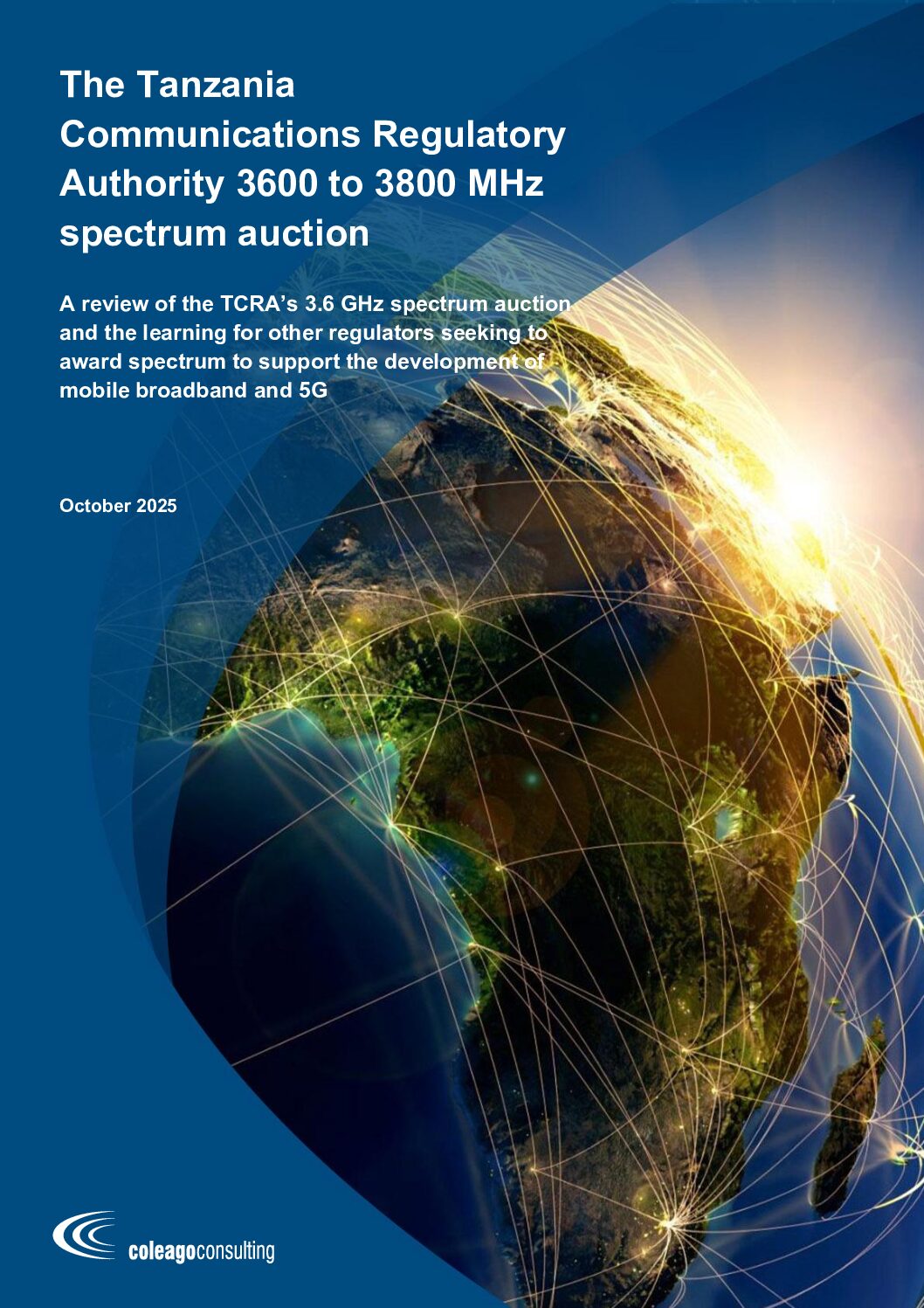Tanzania’s 3.6 GHz Spectrum Auction: Key Insights and Lessons for Future 5G Awards
Tanzania’s recent 3.6 GHz spectrum auction marks a major step toward 5G, but its design choices raise important questions about efficiency and fairness. Coleago’s latest white paper reviews the TCRA auction and shares key lessons for regulators and operators shaping future 5G spectrum awards.
The Tanzania Communications Regulatory Authority (TCRA) recently completed its auction of 200 MHz of C-Band spectrum in the 3600–3800 MHz range — an important step in supporting the rollout of next-generation mobile broadband and 5G services across the country.
The 3.6 GHz band is central to 5G deployment worldwide, offering the ideal balance between coverage and capacity. Tanzania’s decision to bring this spectrum to market reflects a strong commitment to enabling investment, innovation, and digital inclusion. However, as our latest white paper explains, some aspects of the auction design may have limited its overall efficiency — offering useful lessons for other regulators planning similar awards.
In our report, “The TCRA 3600–3800 MHz Spectrum Auction: A Review and Learning for Regulators,” we analyse how the auction was structured, how operators responded, and what the results reveal about effective spectrum management in emerging markets.
The study highlights several positives in the TCRA’s approach:
- A clear, transparent award process with sensible timelines.
- Reserve prices set at realistic levels relative to market benchmarks.
- Reasonable coverage and quality-of-service obligations.
- Flexible, though not overly generous, payment terms.
- A pragmatic 15-year licence period providing long-term investment certainty.

However, the paper also identifies key challenges. The TCRA packaged the 200 MHz of spectrum into four large 50 MHz blocks and adopted a first-price sealed-bid auction format. While straightforward to administer, this design reduced flexibility for bidders, increased exposure risk, and limited the ability to express differing valuations for incremental spectrum. The result was an outcome where some operators paid significantly higher prices per MHz than others — suggesting that the auction may not have delivered a fully efficient allocation.
Coleago’s analysis suggests that smaller block sizes (e.g., 10 MHz) combined with a multi-round ascending clock auction could have supported a more competitive, transparent, and economically efficient result. Such formats also help bidders manage price discovery and reduce the risk of “winner’s regret” — common issues in sealed-bid processes.
For regulators across Africa and other developing 5G markets, Tanzania’s experience provides valuable insight into how spectrum packaging, pricing strategy, and auction format interact to influence both short-term revenues and long-term network investment. As 5G spectrum demand continues to grow, getting auction design right will be critical to ensuring fair competition and efficient use of national spectrum resources.
Other insights

Implications of a Full Transition from DTT to IPTV in the UK by 2035
In May this year, Coleago published a report prepared for the UK Spectrum Policy Forum which provides a technical and strategic assessment of future options for use of the UHF band (470–694 MHz) in the United Kingdom beyond 2034.

The European 5G Fairytale
For years, European policymakers and telecom operators have touted the impressive figure: “89% 5G coverage of populated areas.” On paper, this paints a picture of near-ubiquitous, high-speed connectivity. Scratch the surface however, and the reality looks quite different.

Maximising Shareholder Value in Spectrum Auctions
Spectrum auctions, while common in the telecom industry, are complex and high-risk events that can significantly influence a company’s long-term performance. Missteps, especially vague auction objectives and poor valuation discipline, can lead to substantial destruction of shareholder value.

Spectrum and Regulatory Challenges Related to eVTOLS
Electric Vertical Take-Off and Landing (eVTOL) aircraft are poised to revolutionise urban mobility, with commercial operations expected to begin as early as 2025 and significant growth anticipated by the 2030s.

Future of the UHF Band after 2024: An Analysis of Options in the UK
Coleago Consulting in collaboration with its client, the UK Spectrum Policy Forum, has released a landmark report, “Future of the UHF Band After 2034,” setting out a detailed assessment of the United Kingdom’s Ultra High Frequency (UHF) spectrum landscape. The report looks at the industry trends and the critical trade-offs required to balance the needs of Digital Terrestrial Television (DTT), Mobile Communications, and Programme Making and Special Events (PMSE).

The Polish 700 and 800 MHz Spectrum Auction: Insights and Global Lessons
Poland’s final low-band spectrum auction marks a pivotal moment in Europe’s 5G rollout, offering key lessons in auction design, cross-border coordination, and strategic spectrum management.